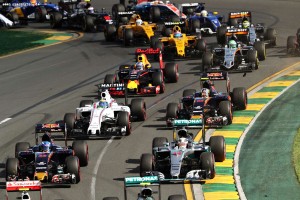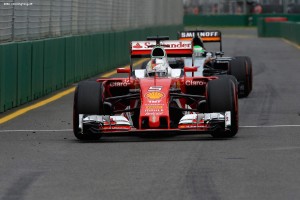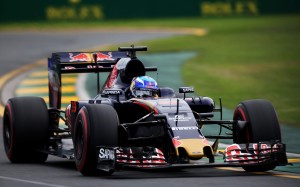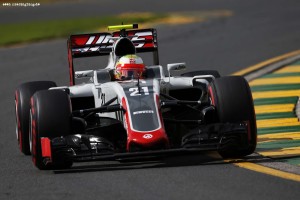When the new tyre rules for 2016 were announced, giving teams a choice of three tyre compounds to choose from in races, it was clear that this would create more variables and potentially make the races more interesting. This is exactly what happened with the opening round in Melbourne
 Several drivers used all three available compounds and the lead battle between Nico Rosberg and Sebastian Vettel, pivoted on a key decision when the race was stopped for Fernando Alonso’s accident. We’ll analyse where and how Ferrari made their mistake as well as look at the strategy argument at Toro Rosso and consider how Haas F1’s female strategist Ruth Bascombe steered Romain Grosjean to score eight points on the team’s debut.
Several drivers used all three available compounds and the lead battle between Nico Rosberg and Sebastian Vettel, pivoted on a key decision when the race was stopped for Fernando Alonso’s accident. We’ll analyse where and how Ferrari made their mistake as well as look at the strategy argument at Toro Rosso and consider how Haas F1’s female strategist Ruth Bascombe steered Romain Grosjean to score eight points on the team’s debut.
Pre-race expectations
Rain on Friday in Melbourne had restricted running, so no one had a clear picture of how the tyres would perform. The teams had plenty of time in testing to evaluate all the tyre options on their car, but the Barcelona surface is high grip in comparison and has more high-energy corners. Graining is always the problem at Albert Park as the cars slide on the low grip surface.
Pre-race expectations were that one stop could be possible for some cars, with a 40-lap stint on the medium tyres. But getting the mediums up to temperature was an issue for some. A pit stop in Melbourne costs 23 seconds, which on the higher end of the scale, so it is always desirable to try to make fewer stops if possible.
Ferrari vs Mercedes – Why did Ferrari not cover Mercedes after the red flag?
 Ferrari led 34 of the 57 laps of this race, but failed to win it. The reason is not quite as it has been portrayed, rather it was down to decisions made before the race. The team committed to favouring supersoft tyres for the race; they saved a set of supersofts during the final practice session. This meant that they only had one set of softs available for the race.
Ferrari led 34 of the 57 laps of this race, but failed to win it. The reason is not quite as it has been portrayed, rather it was down to decisions made before the race. The team committed to favouring supersoft tyres for the race; they saved a set of supersofts during the final practice session. This meant that they only had one set of softs available for the race.
Vettel led the first stint, but Mercedes pitted Rosberg from third place early, on Lap 12, to undercut Kimi Raikkonen for second place. Ferrari had no choice but to cover the move with a stop for Vettel. They left Raikkonen out. They fitted the supersofts Vettel had saved from practice. Rosberg, however, had switched to softs and from that point onwards was in the driving seat, even if there had not been a red flag. This is because Vettel had been pulled into stopping earlier than ideal and with only one set of softs to play with, his options were now limited.
Mercedes’ intentions were clear when they pitted Hamilton on Lap 18, fitting his only set of mediums. This indicated that they were confident they could do a one stop race and reach the end on that tyre. So when the race was stopped for Alonso’s accident a lap later, it was clear to Ferrari that Rosberg too would be restarting on the medium tyres and going to the finish.
So how best to counter that? Vettel would still have track position ahead of Rosberg, with Raikkonen now third behind the German. One tactic would have been to split the strategies, with Raikkonen on medium tyres to cover off Hamilton coming through (although it was academic as Raikkonen retired not long after the restart).
Ferrari were reluctant to try to cover Mercedes by sending Vettel out on mediums, partly because they knew the Mercedes would switch the tyres on more quickly and would probably pass Vettel soon after the restart and partly because they weren’t convinced they could manage that long a stint and be able to hold Hamilton off at the end of the race that way.
So they restarted with supersofts but were on the back foot because Mercedes knew that Vettel would not be able to maximize the supersofts as he’d have to run them longer than ideal – he would not be able to switch to the soft for the final stint until Lap 35; the final stint length being dictated by how long the soft would last. If Ferrari had two sets of softs available, they could have had more flexibility. So it’s not correct to say that a bad tyre choice in the race cost Ferrari the win; the damage was done before the race started.
What was going on at Toro Rosso?
 One of the more entertaining cameos of the race was the strategy row at Toro Rosso, which ended up costing the team a lot of points. The car was very quick all weekend and both drivers qualified well, setting them up for a strong double points finish.
One of the more entertaining cameos of the race was the strategy row at Toro Rosso, which ended up costing the team a lot of points. The car was very quick all weekend and both drivers qualified well, setting them up for a strong double points finish.
Verstappen and Sainz were 5th and 6th at the restart, where they both went out on new soft tyres, reluctant to attempt to reach the finish on a set of mediums. However the cars behind Hamilton had gone for medium tyres and were aiming to get to the finish; Massa, Grosjean, Hulkenberg, Bottas and Palmer. So the danger was pitting too early and coming out into that group.
Before long, however, both Sainz and Verstappen were complaining about the tyres going off. In fact the pace was fine, but they convinced the team that a change was needed. Toro Rosso should have left them out for another few laps before taking on new medium tyres, to create an offset so they could have much fresher tyres to pass the one-stoppers in the closing laps.
Although Verstappen was ahead on the road, Toro Rosso did the right thing in pitting Sainz first because the Dutchman would have come out behind Palmer if he had been pitted on Lap 31. Where the mistake was made was in Verstappen unilaterally deciding to pit on Lap 32, without the team calling him in once they were ready for him.
This cost five seconds and dropped him to 12th behind Perez. By pitting so early they did not have enough tyre differential against the one stoppers to overtake them and so ended up losing to Massa, Grosjean, Hulkenberg and Bottas – a very disappointing outcome for the Toro Rosso team.
They will also have to speak to Verstappen about pitting of his own volition, as that is a cardinal sin in Formula 1. The drivers don’t have a full picture of what is behind them on the road, so are in no position to decide pit stop timings.
Points on debut for Haas
 The Haas F1 team had a very positive start to F1 with eight points for Romain Grosjean’s sixth place. The car showed very good pace in the race, easily holding off the Force India of Nico Hulkenberg, so we can assume that the team is capable of many more points finishes like this.
The Haas F1 team had a very positive start to F1 with eight points for Romain Grosjean’s sixth place. The car showed very good pace in the race, easily holding off the Force India of Nico Hulkenberg, so we can assume that the team is capable of many more points finishes like this.
Grosjean’s result in Australia was down to the sensible strategy of starting on the soft tyre. Having messed up the complex elimination qualifying format on Saturday, Grosjean was starting down in 19th place on the grid. The only way to score points from there is to maximize your potential in the event of a Safety Car, which is what a soft tyre at the start does.
Interestingly, when the Safety Car was deployed initially for Alonso’s accident with the other Haas driver Gutierrez, the Haas team did not prepare in the pit lane for Grosjean, indicating that the team’s female strategist Ruth Bascombe was reasoning that the accident was severe enough to warrant a red flag. Others pitted, including Bottas for Williams. But she was right. When the red flag came out, Grosjean effectively got a free pit stop.
From there it was a no-brainer to put Grosjean onto the medium tyres and he was 9th at the restart. Raikkonen’s retirement and the shenanigans at Toro Rosso mentioned above, brought him up to sixth at the finish. A great afternoon’s work by driver, strategist and debutant team.

